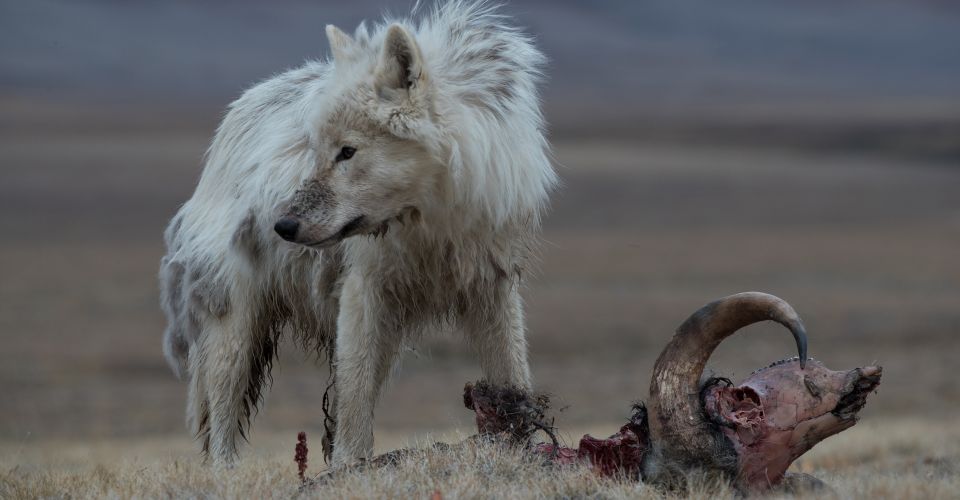Kingdom Of The White Wolf Interview: Ronan Donovan On Nat Geo WILD’s New Event Series

National Geographic photographer and explorer Ronan Donovan talks with Screen Rant about his journey to the arctic for the three-part event series Kingdom of the White Wolf. The series provides an unprecedented look into the lives of some extraordinary animals, as Donovan gets up close and personal with a species integral to the Arctic’s complex eco system, and also one that is misunderstood, or perhaps not understood enough. The result is a series that turns its subjects into real characters and their survival into one of the most compelling narratives on TV.
But Kingdom of the White Wolf is more than another nature documentary. By making Donovan and his photography a central part of the series itself, the program becomes a hybrid of sorts, fusing top-notch filmmaking with some truly gorgeous photographs, captured while the series itself unfolds. As such, Kingdom of the White Wolf offers a fascinating viewing experience, one that simultaneously tells the story of a pack of white wolves and the individual documenting them.
In addition to speaking with Donovan to hear firsthand how the series came together, Screen Rant has two exclusive clips from the series. The first demonstrates how the wolves communicate, with their familiar and seemingly pensive howls. The second, offers a rare glimpse at a wolf pack forming and becoming a formidable hunting party. As Donovan notes, the predators are put in a strange predicament where, in order to eat, they must first venture into harm’s way. Check out the pack formation and wolf calls clips below, along with the interview with National Geographic Explorer Ronan Donovan.
I wanted to start off by congratulating you on having the coolest job in the world. I also wanted to ask, is that notion difficult to process when you’re out there actually doing what I assume is the difficult work of exploring and documenting nature in this way?
I mean the actual work is very hard, like physically, emotionally demanding. I mean, this last assignment in the Arctic, I tore the meniscus in both my knees throughout the assignment. The first one in my left knee in the first month of the project. I just had to walk it off and get on with it. And then I tore the second knee like three weeks before the end. I knew I did awful things to them, but I didn’t really have much of an option to get help or stop working, because I had a lot of pressure on myself. So you know, it’s a common sentiment that it’s like, you know, this is a really amazing job, but it also has its great challenges as well. And that was definitely one of them for this last assignment.
How long are you actually out there following these subjects and what does that experience give you in terms of understanding these animals in their habitat? And then conversely, what do you learn about yourself when you’re out there?
Just following the animals and the subjects, the set up was, essentially there were two other guys on the team and we had a base camp that we set up that was about 20 miles away from the core range of this main pack of wolves. And so basically we had four wheelers to be able to keep up with the wolves, as well as carry the equipment, you know 150 pounds of equipment. Food, tent, your sleeping stuff and then another two full gas tanks in fuel cans to be able to keep up. So everything dictated how much the wolves were going to move. I had about 250 miles that I could get out of all the gas that I had in the machine that I would carry.
You could do three or four days typically, because the wolves would just travel and then you’d have to make sure you didn’t run out of fuel before you got back to camp. The longest day was 65 miles following the wolves continuously, while they hunted over the course of 40 hours. And that was the longest day that I did out there and it was just utterly exhausting. You know the sun’s up the whole time. So you have this weird kind of ball of energy that never sets, and that’s backed by all the continuous movement. You’re on this machine, you’re not sitting down, you’re in the horse riding stance, getting bucked around on awful terrain. So you can’t exactly fall asleep. It’s not like driving a car where I could never last more than 20 hours driving a car straight because you’re comfortable and you fall asleep.
The machine and the pace and following the wolves just keeps you up; it propels you to keep going. And they’re hunting and you’re having to try to document that, because it’s one of the peak physical, mental evolutionary aspects of the animal’s life that makes them what they are, and you’re trying to capture all this. So that was what would keep me up and driving and doing horrible things to my body. What I learned about myself from doing this project is some of the things that make me really good at my job, which is kind of a stubborn drive to achieve and succeed and document and share these animal stories. That stubborn drive is also … it can be a bit self-defeating in the sense that self care is really challenging, I think, on these longterm field projects. Just the physical aspects of it. I’ve harped on that a lot, but it’s … For this assignment it was by far the hardest all around and most demanding, physically and emotionally.
Additionally, I’ve never done television before and there was a lot of pressure involved; people went to bat for me a lot on this project, to give me this opportunity. It’s big budgets. There’s obviously big expectations and so there was a lot of that in my mind throughout. But that was interspersed with these incredible wildlife moments where you get to witness an animal that’s rarely seen by anyone and even more rarely seen in its relaxed state, essentially just being wild wolves and ignoring my presence the whole time. And that was just an incredible opportunity and treat to be able to have that experience.

It’s incredibly interesting watching the way the wolves were aware of you being there but didn’t seem to really react to you all that much. Can you talk about the process of following the wolves around and getting to know them individually, and eventually earning their trust enough that you can insert yourself into situations they’re in without distracting them from what they’re trying to do?
Initially, locating wolves, you’re trying to find a wolf den. We used a helicopter for that process, just trying to cover a bunch of ground looking for these green patches in the landscape, which are indicative of a den that’s been fertilized by urine and feces for hundreds of years on a pretty barren tundra desert-like landscape that doesn’t have very much in the way of nutrients. So the wolves, just by being there and creating a den, create this lush little Eden spot on what’s typically a brown landscape. So you find the den and then maybe it’ll be active, maybe not. In this case, in the first episode, all the dens we found were all iced in and there were no wolves.
That added a freakout of like, ‘Oh gosh, I just said I could do this project, that I can find wolves, and I can’t.’ And then once we did find a den with pups, it was in this far away valley, and it was pretty sandy soil, so it must not have had the same weather event. The rain event didn’t affect it and it wasn’t frozen in. That’s why they were able to use that den. After that, it was just… gaining their trust is just a series of neutral encounters with them, because there’s nowhere to hide, you’re not trying to sneak up. It’s not like you’re sitting in a blind or a hide, which is typical of some of the other wildlife work where you’re actually trying to keep yourself hidden.
You just present yourself and they react accordingly. They’re going to be curious probably about what you’re doing because they’ve never been shot at or they’ve never had a negative encounter with people. Some of the wolves maybe have never seen people, especially the younger ones, at least the pups. They have no reason to fear anything other than other wolves and the occasional polar bear. So therefore, they’re going to be curious about anything else. So that’s how they saw me. And that’s how they see humans as just kind of this interesting third animal in a landscape. We’re not a threat, we’re not seen as prey; we’re just kind of another animal out there in some ways. It’s a fascinating perception of what wolves think of humans in this part of the Arctic. They’re not scared of us and they don’t see us as prey.

Much of the first episode delves into the ways in which the pack has a social dynamic and cares for one another or shows affection toward one another. It also underlines the role that the wolves play in maintaining the ecosystem around them. In what way do you think the series will help dispel some misconceptions about these wolves and help create a new image for them?
Yeah, I mean the main goal is to showcase a wild family of wolves that can exist in its own ecosystem, its own place, be a positive force in the landscape and have no negative encounter with people. Which is the honest story about how wolves have lived for tens of thousands of years and that it’s only in recent times in human history where we as humans started to domesticate the animals that wolves prey on: sheep, goats, cattle. And then we came into conflict with the wolves because we wanted to eat the same thing. And so, on Ellesmere Island, there’re no people who live there and raise livestock, and there is no competition with human hunters there, which is another conflict of the wolf/human relationship. And so it’s this really exciting place just to show what wild wolves are like, without this haze, this cloud of human interaction.
What I hope people will take away from it is seeing how intimate wolves can be among themselves, just in their family structure. How sweet they are to the pups, how sweet they are with each other. They have need to communicate and cooperate in order to achieve something together that they can’t do on their own, which is why people live in social groups, because we can do greater things as a group than we can on our own. Trying to highlight those similarities, which is kind of the first step in empathy and understanding that humans are capable of when we’re trying to understand other people, other cultures, and extending that into animals as well.

You were out there for quite some time documenting these wolves, and I’m sure you had a lot of experiences that maybe didn’t make the actual final cut of the series. For you personally, what was the most surprising thing you came across in the process of making this series and in your time documenting these wolves?
One of the most incredible experiences and striking that didn’t make it in, was the longest follow day where it was, 40 hours straight and 65 miles that we covered. This was after the matriarch female had disappeared from the pack, so the pack was in a little bit of disarray. They waited around for a number of days to see if she’d come back, and they got hungry so they had to go out and hunt. They brought the pups along that were about 12 weeks old at that time. And they went on this 65-mile jaunt, which is a really long way for little pup legs, and the adults were exhausted and the pups were dragging behind, whimpering and howling while they’re running, and having this really, really hard experience.
Later, the adults were hunting multiple herds of muskox, just testing them and failing. One of the wolves actually got smashed and steamrolled and stampeded, before getting up and trying to find another herd of muskox to test. And this was over 40 hours. They killed two Arctic hares that the adults wouldn’t share with the pups because the adults were ravenous at that point. And kind of the code is: if the adults don’t eat then there’s no way the pups are going to get food. So the adults have to be strong and healthy in order to find more food for the pups.
Then there was this really tense moment where [the wolves] went from sea level up to 2,500 feet over this mountain dropdown, this dramatic icy chute on the edge of this mountain. I thought they all died because it was ice. I couldn’t follow them. It took me an hour and a half to get around the mountain to get back to them. I was thinking that at least a few of the pups must have died in this avalanche chute, basically. But I found them again, and they were all just curled up sleeping and taking a nap. They were totally fine.
That was just one of the most impressive feats of animal physical fitness, as well as seeing how they stay together as a cohesive pack. They didn’t leave any pups behind. They didn’t leave any other adults behind. They stayed together through a really challenging session and eventually they made another kill a couple of days later and had a really good feed. That was kind of heartwarming to think that they were able to keep going and function as a pack without their matriarch.

One of the things that’s really interesting about this series, is that it;s about the wolves, but on another secondary level, you and your photography become another aspect of the story. How does that work and how do you balance directing the audience and becoming a part of the story in this way. How does that work for you?
Yeah, I mean that’s not my happy place I would say [laughs]. This whole project came out of my wanting to do a magazine story as a photographer for National Geographic Magazine. The editor that I’ve worked with my entire five years at National Geographic, said to me, ‘I would love to do this story. We just no longer have the budget to do this.’ She said, “But you know, TV has those budgets. They’re right across the hall. Let’s go over and see what’s possible.’ So this whole project came out of our desire, myself and the editor, to do a magazine story, a photography story. And then it went through a couple of iterations and they asked would if I would be willing to go up there with a big crew and do this whole production and all this, and that’s not the way to do it.
So they turned that down and then eventually they asked if I would be willing to be on camera as one of the characters and be filmed doing the process. And I agreed. But you know, I never aspired to do television, to be on TV. I don’t own a TV. I don’t watch Nat Geo WILD. It’s not like it was this goal of mine, to always do something like this. I wanted to tell the story of wild wolves, but I realized that television is the widest audience for consuming these types of wildlife stories. I wish the magazine had more of a following than it currently does, but that’s just the nature of print media. And so I saw an opportunity in agreeing to be on camera and to be filmed doing my process as a photographer and filmmaker as a way to reach a wider audience.

One of the hardest balances for me in this project was that I’m also a wildlife cameraman, so I filmed half of the natural history for this series. And trying to juggle photographing for the magazine – because there’s a story out in the current [September 2019] issue on the wolves – then also having to film for this TV series was really hard. There was another full time dedicated director of photography up there, his role was to film me during the process and then also to film natural history. And so the two of us would kind of shift back and forth. But that was hard. That was hard for me. Additionally, I was by myself a lot, so I wasn’t able to do side-by-side video and photo. As a result, there were several moments where I had to choose what it was going to be. ‘Is this going to be a sequence of photos or going to be a sequence of film?’ That was a balance that was hard for me.
Where do you go from here? What is your next project that you’re working on, if you are working on anything at the moment?
Yeah, well the immediate project is going back and trying to find that same pack again, but in winter. I always wanted to go see the wolves in winter. The powers that be were cautious about that, and they wanted to do this initial round in the summer and to see how it goes. It really comes down to how well this show rates. If it does well then I am going to push to go back in winter because these Arctic wolves, they’re white wolves, they evolved on a predominantly snowy white landscape and they’re at their strongest in winter, when their prey, the muskox, are at their weakest. So I want to see that. I want to go up there when it’s negative 30 in February and the sun is just coming up from the horizon for the first time in five months when the wolves have these big, huge, bushy winter coats, and they’re hunting muskox, which are tired and weak and there’s breath and blood and white landscape. It would would just be gorgeous.
Kingdom of the White Wolf premieres Sunday, August 25 @8pm on Nat Geo WILD.
About The Author


















